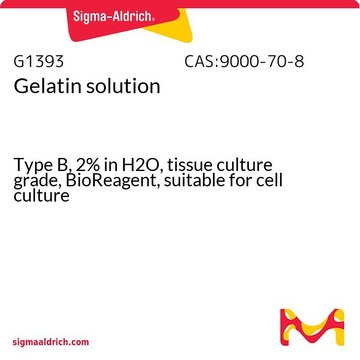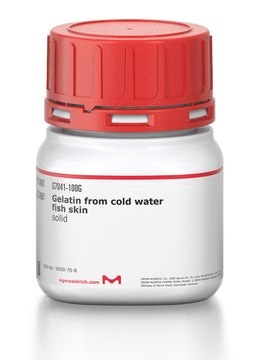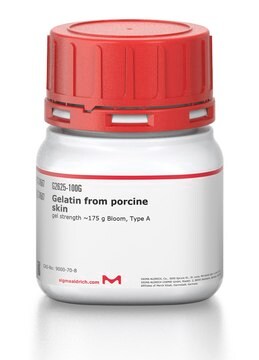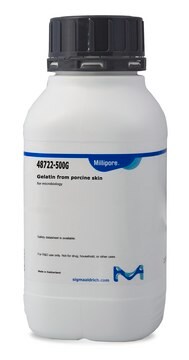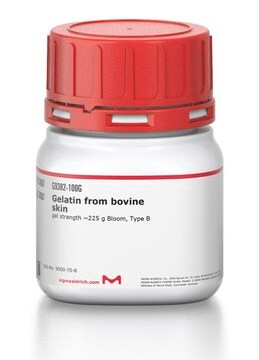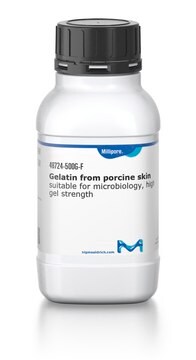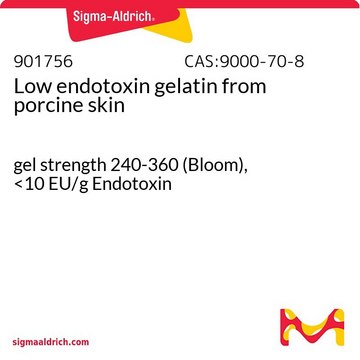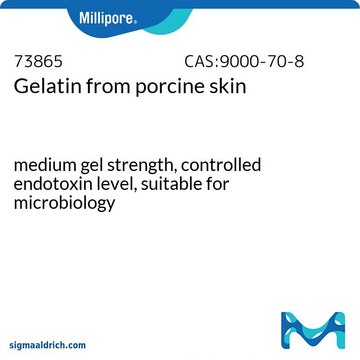G1890
Porcine Gelatin
from porcine skin, Type A, powder, gel strength ~300 g Bloom, suitable for electrophoresis and cell culture
About This Item
Productos recomendados
product name
Gelatina from porcine skin, powder, gel strength ~300 g Bloom, Type A, BioReagent, suitable for electrophoresis, suitable for cell culture
biological source
Porcine skin
Quality Level
sterility
sterile
type
Type A
product line
BioReagent
form
powder
mol wt
50—100 kDa
packaging
pkg of 1 kg
pkg of 100 g
pkg of 500 g
concentration
70—90% Biuret
technique(s)
cell culture | mammalian: suitable
electrophoresis: suitable
surface coverage
100‑200 μg/cm2
solubility
H2O: soluble 50 mg/mL, clear to hazy, faintly yellow
shipped in
ambient
storage temp.
room temp
¿Está buscando productos similares? Visita Guía de comparación de productos
General description
Application
Features and Benefits
- Sterile gelatin sourced from porcine skin.
- Free from proteases.
- In the form of gelatin powder for convenient and easy handling.
- Versatile for use in cell culture and electrophoresis techniques.
- Provides adequate surface coverage for various applications.
Components
Caution
Preparation Note
Storage Class
11 - Combustible Solids
wgk_germany
nwg
flash_point_f
Not applicable
flash_point_c
Not applicable
ppe
Eyeshields, Gloves, type N95 (US)
Certificados de análisis (COA)
Busque Certificados de análisis (COA) introduciendo el número de lote del producto. Los números de lote se encuentran en la etiqueta del producto después de las palabras «Lot» o «Batch»
¿Ya tiene este producto?
Encuentre la documentación para los productos que ha comprado recientemente en la Biblioteca de documentos.
Los clientes también vieron
Artículos
Attachment Factors for 3-Dimensional Cell Culture
The extracellular matrix (ECM) is secreted by cells and surrounds them in tissues.
3D cell culture overview. Learn about 2D vs 3D cell culture, advantages of 3D cell culture, and techniques available to develop 3D cell models
Cancer stem cell media, spheroid plates and cancer stem cell markers to culture and characterize CSC populations.
Nuestro equipo de científicos tiene experiencia en todas las áreas de investigación: Ciencias de la vida, Ciencia de los materiales, Síntesis química, Cromatografía, Analítica y muchas otras.
Póngase en contacto con el Servicio técnico
